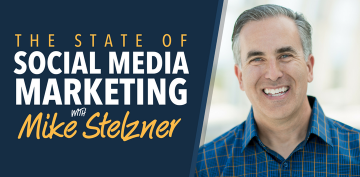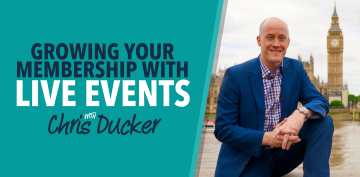Most memberships are focussed on helping people to reach a goal or achieve some sort of positive outcome.
Whether you enable this with courses, worksheets and tools, community or something else – it's the result that matters.
Running a free online challenge as part of your audience building and lead generation strategy taps into this in a big way and as a result can be one of the most effective tactics for attracting new members.
If you run a challenge that helps people get a specific outcome; then not only are you delivering value but you're also proving that you're capable of helping them to get results.
That's an extremely compelling motivator for joining your membership for anyone wanting to take the next step towards achieving their larger goals.
Free challenges – the basics
Before we go any further, let’s make sure we’re on the same page.
Broadly speaking, a free challenge works a little something like this:
- You deliver a free course or program (via email or a dedicated section of your website) using different content formats (like webinars, live videos, and articles)
- The challenge runs to a specific timeframe (e.g. 30 days)
- Everyone taking part does so at the same time and works towards the same specific outcome
- The outcome should be easily achievable in the timeframe, with a focus on accountability and guidance rather than teaching specific skills
- An online accountability community runs alongside it – usually a free Facebook group
Some top tips for creating and structuring your free challenge:
- Plot out the time period your challenge will run for and give your participants (and yourself) enough time to get the tasks done, have check ins, and to slip and have other things come up in their lives
- Use email marketing automation software to send your content out consistently
- Use a variety of content – activities, advice, progress checks (where you encourage people to use a Facebook group or other community), and more
- Keep it simple and achievable – by choosing an outcome that isn’t overwhelming, or so advanced that you need to give constant assistance to participants, and accompanying that with an accountability community is really compelling
The benefits of running a free challenge
Once people are signed up and taking part in your free challenge, they become a major part of your audience.
Their regular exposure to you quickly builds your relationship, as they come to trust you and your knowledge.
If they achieve a positive result from your challenge, then you’ve established your record as a helpful source of solutions to their pain points and problems.
The great thing about using this free challenge structure, rather than running a free course, is that you can create an event-type feeling around it.
Having a signup deadline and a set start date, so that everyone joins, progresses, and finishes together is like putting your membership on steroids.
This urgency and scarcity, combined with the community feeling, is really powerful.
The intensity of focus on you and your offering produces a groundswell of noise and attention on you and your offering.
You could have 100 people take part in a free email course throughout a year or 100 people could do your challenge in the same month. The visibility you get from the latter is many degrees greater.
This will make promoting your membership (which you want to make sure your challenge leads into) so much easier to do, as people have essentially been able to trial your ability to help them achieve positive change.
But it’s essential that you have that clear lead-in to your membership, otherwise you’re giving away value for free and not getting anything back.
Bridging the gap between your free challenge and membership
Making sure your free challenge leads invitingly to your membership is just as important as creating the challenge in the first place.
After all, you’re doing this to grow your membership, not purely out of altruism!
When someone is done with your challenge, they should know what the next step they need to take is.
There are a few ways you can gear your free challenge towards securing new members, including:
- Holding a Q&A call or webinar at the end of your challenge for everyone who has taken part. You can summarise what people have learned and answer questions, but also reference your membership and make it clear that it is the natural next step.
- You could point people towards a specific piece of content within your membership that is tied to the goal you’ve helped them achieve
- If you run live webinars or Q&A sessions for your members, give challenge participants access to that month’s call. This will give them a taste of what happens inside your membership, what they are missing out on, and what they can get when they finish the challenge
- At the end of the challenge, offer an exclusive free trial of your membership or a discount. Tap into that urgency and scarcity mentioned earlier and offer access to this exclusive offer for 48 hours (or similar)
- Upload the challenge content in your membership before you start and give participants the option of having a ‘shortcut’ if they don’t want to wait each day for their next step. Let people know about this at different stages – day one, day 10, and day 20 (for example)
- You could run the challenge inside your membership site by offering it as a free tier of membership, making the transition to paid membership even easier
All of these approaches should help you make it easier for your participants to understand the value in your membership and make them joining as easy as possible – making it less of a leap of faith and more of a safe and sensible next step.
Repurposing your free challenge for maximum value
Once your challenge is over… that’s only the beginning!
There are so many possibilities you can explore after you’ve created your challenge and shared it for the first time:
- Take some of the individual steps from the challenge and release them as blog posts. 5 or 6 of the 30 individual steps will not damage the validity of your course, but it will deliver value to your audience in a new way and repurpose the content you spent time creating so you get a better ROI
- Create case studies – whether video, audio, or written, case studies will help you create strong social proof that will drive demand for your challenge the next time you run it
- If you didn’t previously have a free Facebook group, then running a challenge can serve a dual purpose: starting your popup Facebook group for the challenge gives you the foundation for creating a longer-term Facebook group. Rebrand the group from being solely about your challenge to being about your membership
- Run the challenge several times a year and refine it each time with the lessons you’ve learned from previous iterations (plus the social proof from previous participants)
- Take your challenge and turn it into a book, a talk, or a website in itself. We repurposed our challenge into our first book, Member Machine!
Using a Challenge to launch Membership Academy
Free challenges fit into so many different strategies and work for all kinds of memberships.
They’re highly adaptable, have long-term value, and are great for repurposing.
Running a challenge was a key part of our launch strategy when we pivoted from consultancy to membership.
We only had 2 or 3 months to do it, but the 30 Day Membership Challenge was a powerful tactic for us.
We received hundreds of email sign-ups, many of whom became members, and it was a key part of how we went from zero to 100 in a short amount of time.
We put the full challenge inside Membership Academy, ran the challenge several times over the years, repurposed the course into a book, and did plenty of the other steps we’ve recommended in this post.
Free challenges get our seal of approval and they should get yours, too, if you’re looking to grow your audience and recruit new members.






